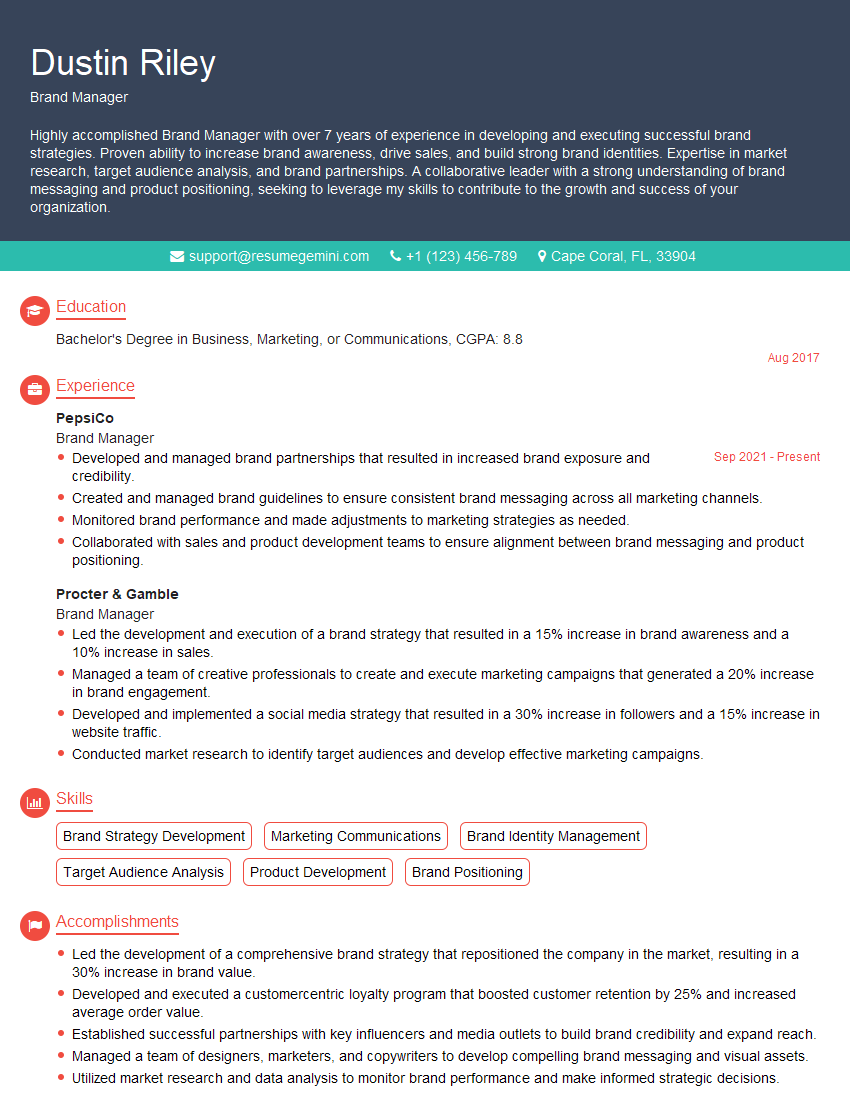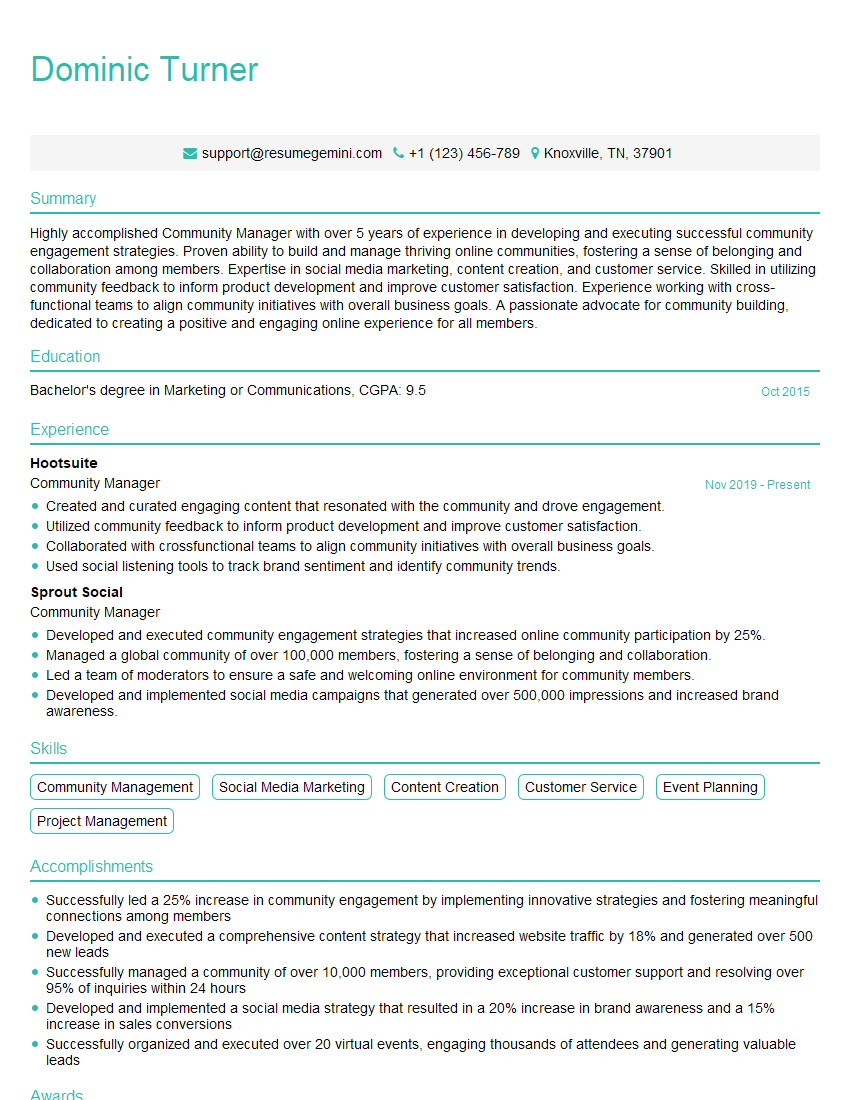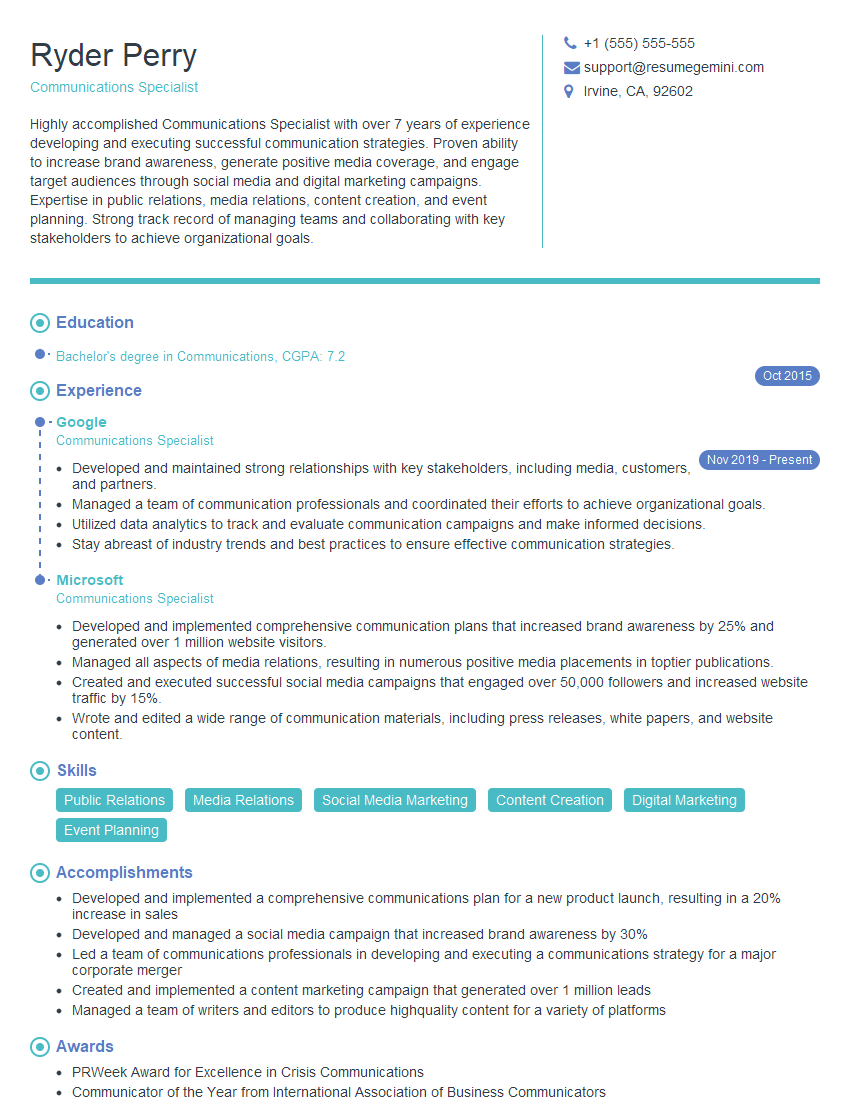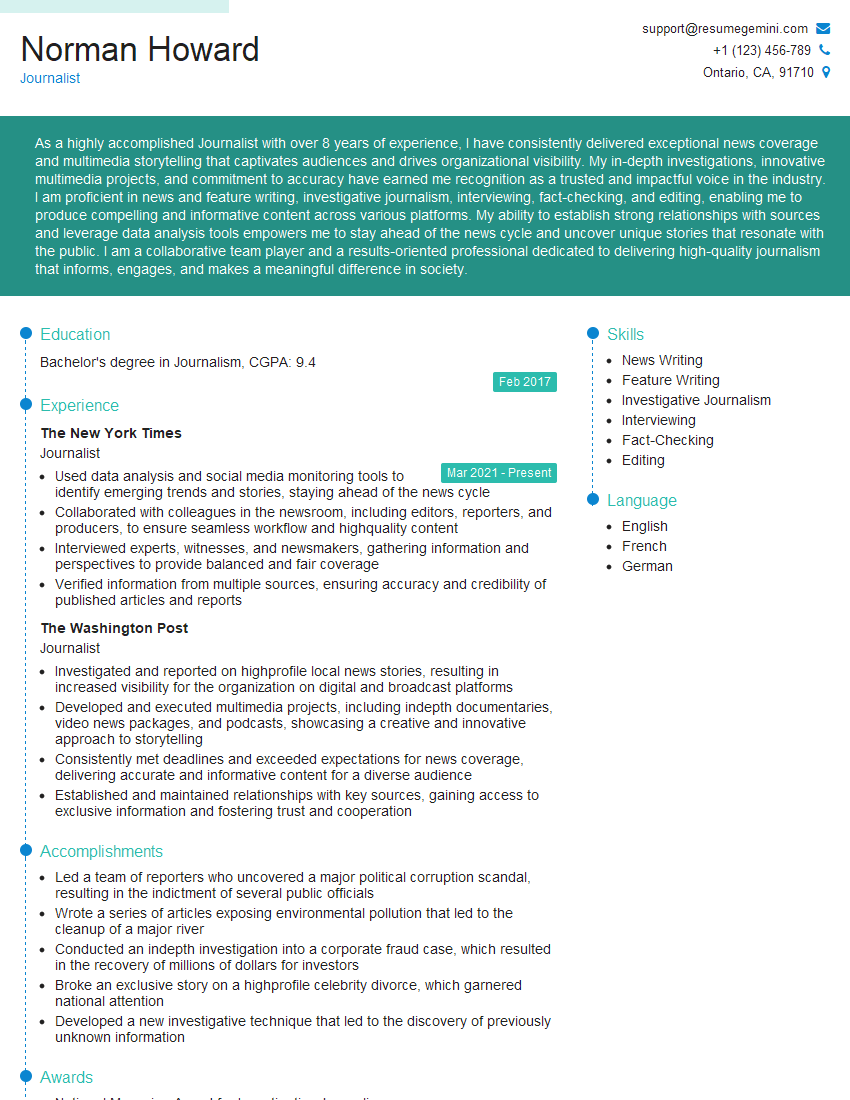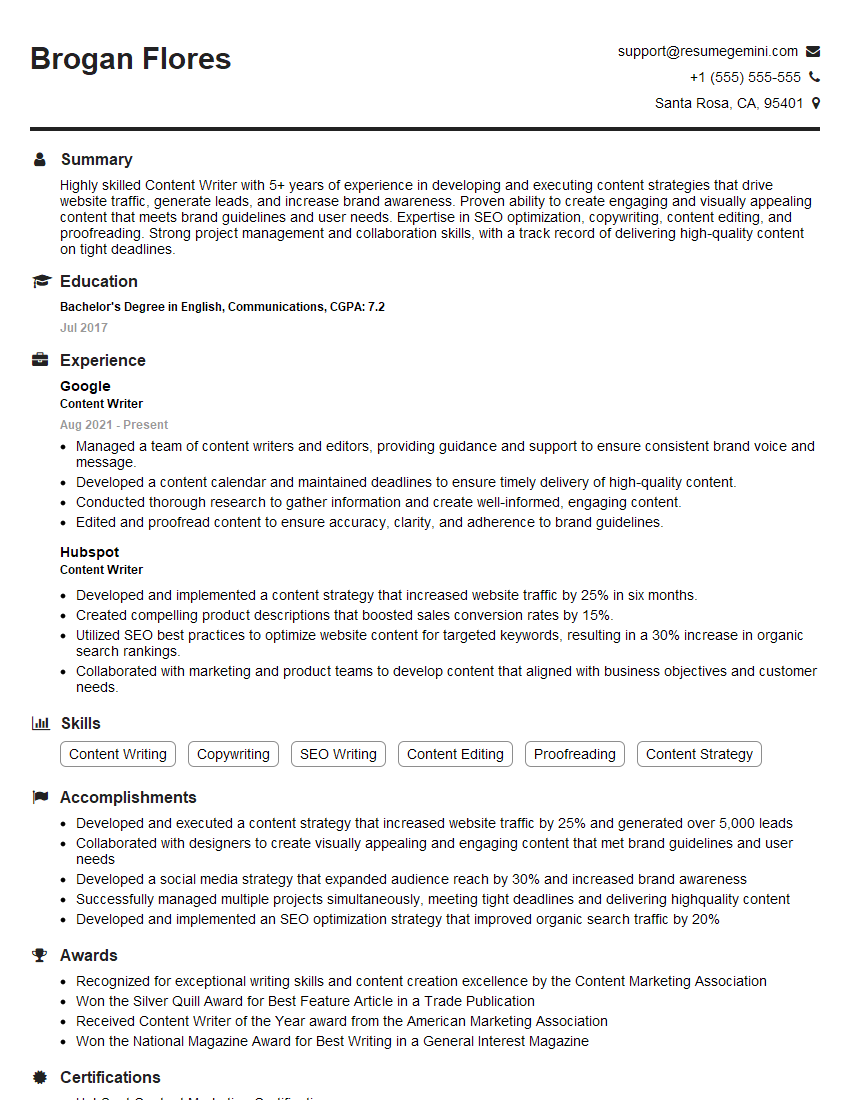Are you ready to stand out in your next interview? Understanding and preparing for Sample Communication Skills interview questions is a game-changer. In this blog, we’ve compiled key questions and expert advice to help you showcase your skills with confidence and precision. Let’s get started on your journey to acing the interview.
Questions Asked in Sample Communication Skills Interview
Q 1. Explain the difference between verbal and non-verbal communication.
Verbal communication uses spoken or written words to convey a message, while nonverbal communication relies on body language, facial expressions, tone of voice, and other non-linguistic cues. Think of it like this: verbal communication is the what you say, while nonverbal communication is the how you say it. For example, saying “I’m fine” in a flat tone while slumping your shoulders communicates something entirely different than saying the same words with a bright smile and energetic posture. The effectiveness of a message often depends on the alignment between verbal and nonverbal cues; incongruence can lead to misinterpretations.
Q 2. Describe a time you had to communicate complex information to a non-technical audience.
In my previous role, I had to explain a complex data migration project to a group of executives who lacked technical backgrounds. Instead of using technical jargon, I used analogies and simplified the explanation. For instance, I compared the migration to moving furniture from one house to another. I broke down the process into simple, manageable steps, visualized the process with a clear diagram, and focused on the ultimate benefit—improved efficiency and data accessibility. I also emphasized the timeline and potential impact on their daily operations, ensuring they understood the importance of the project despite not understanding the intricate technical details. Their questions were mostly centered on the impact on the business rather than the technicalities, which showed the success of my approach.
Q 3. How do you adapt your communication style to different audiences?
Adapting my communication style involves understanding the audience’s knowledge, background, and expectations. I adjust my language, tone, and delivery method accordingly. For example, when speaking to senior management, I focus on the strategic impact and big-picture implications, utilizing concise and data-driven presentations. When communicating with junior team members, I use more detailed explanations, encourage questions, and focus on the practical application of the information. This flexibility helps ensure that the message is not only understood but also resonates with the audience.
Q 4. What strategies do you use to ensure clear and concise communication?
I employ several strategies to ensure clear and concise communication. First, I carefully plan my message, outlining key points and ensuring a logical flow. Second, I avoid jargon and technical terms unless necessary, and when I do use them, I provide clear definitions. Third, I use visual aids like charts and diagrams to present complex information in a digestible format. Fourth, I actively seek feedback to confirm understanding. Finally, I practice active listening to ensure I understand the audience’s perspective and tailor my message accordingly. This multi-faceted approach ensures that my messages are easily understood and achieve their intended impact.
Q 5. How do you handle miscommunication or conflict in a professional setting?
When miscommunication or conflict arises, I address the situation directly and professionally. I start by actively listening to all parties involved to understand their perspectives. I then clearly state my own perspective, focusing on facts rather than emotions. I encourage open dialogue and collaboration to find a mutually agreeable solution. If the situation involves a significant disagreement, I may suggest mediation or seek guidance from a supervisor to facilitate a constructive resolution. The key is to focus on problem-solving rather than assigning blame and maintaining a respectful and professional demeanor throughout the process.
Q 6. Describe your experience with written communication, including email, reports, and presentations.
My experience with written communication is extensive. I regularly draft and review emails, ensuring they are clear, concise, and professional. I’ve prepared numerous reports, utilizing data analysis and compelling narratives to convey insights. My presentation skills include creating visually engaging slides, structuring information logically, and delivering impactful presentations to both small and large audiences. For example, I created a detailed financial report that was instrumental in securing funding for a new project. It required careful data analysis, presentation of financial projections, and a concise narrative that easily persuaded investors. In another case, I created training materials that effectively communicated complex procedures in simple terms. The key is tailoring my approach to suit the purpose, audience, and context.
Q 7. How do you prioritize communication channels based on urgency and audience?
Prioritizing communication channels depends on the urgency and audience. For urgent matters requiring immediate action, I utilize direct communication methods such as phone calls or instant messaging. For less urgent but important updates, I might use email or internal messaging systems. For announcements to large audiences, platforms like company-wide emails or newsletters are preferred. When choosing a channel, I consider the sensitivity of the information, the need for immediate feedback, and the audience’s preferred communication method. This strategic approach ensures that the right message reaches the right audience in a timely and effective manner.
Q 8. How familiar are you with different communication models (e.g., Shannon-Weaver)?
I’m very familiar with various communication models, including the foundational Shannon-Weaver model. This model, also known as the mathematical theory of communication, illustrates the linear process of communication as a flow of information from a sender through a channel to a receiver. It highlights key elements such as the sender (encoding a message), the channel (medium of transmission), the receiver (decoding the message), noise (interruptions), and feedback. However, it’s important to recognize that it’s a simplified model and doesn’t fully capture the complexities of human communication, particularly the interactive and iterative nature of conversations. I also understand more nuanced models, such as the transactional model, which acknowledges the simultaneous exchange of messages between communicators, and the interactive model which accounts for context and feedback loops. My understanding of these different models allows me to adapt my communication style depending on the context and audience, ensuring clarity and effectiveness.
Q 9. What techniques do you use to actively listen and understand the perspectives of others?
Active listening is crucial for effective communication. My approach involves several key techniques. Firstly, I focus intently on the speaker, minimizing distractions and maintaining eye contact. Secondly, I use verbal and nonverbal cues to show engagement – nodding, paraphrasing key points, and asking clarifying questions. For example, instead of simply saying “I understand,” I might say, “So, if I understand correctly, you’re saying…” This demonstrates that I’m paying attention and accurately interpreting the message. Thirdly, I reflect on what I’ve heard to ensure I’ve grasped the speaker’s perspective, both their facts and their emotions. This involves summarizing their main points and confirming my understanding. Finally, I try to understand the underlying emotions and motivations behind their words. By actively listening in this way, I build trust and foster better relationships, leading to more productive and collaborative outcomes.
Q 10. How do you overcome communication barriers, such as language differences or cultural nuances?
Communication barriers are inevitable, but they can be overcome with a conscious effort. When facing language differences, I utilize translation tools or seek the assistance of interpreters when necessary. More importantly, I focus on clear, concise language and visual aids, keeping my message as simple and universal as possible. For example, in a multinational team, I’d make sure presentations include visual elements that transcend linguistic differences, like charts and diagrams. When navigating cultural nuances, I prioritize research and cultural sensitivity training. I understand that communication styles vary across cultures. Some cultures value directness while others prioritize indirect communication. By understanding these differences, I can adjust my communication style appropriately, preventing misinterpretations. In a business negotiation, for example, understanding a culture’s preference for formality or informality would guide my approach.
Q 11. Describe your experience using communication technology (e.g., video conferencing, project management software).
I have extensive experience utilizing various communication technologies. Video conferencing tools like Zoom and Microsoft Teams are essential for remote collaboration, allowing me to participate in meetings and presentations effectively. I’m proficient in using these tools for screen sharing, recording sessions, and managing participant interactions. Project management software such as Asana and Jira are invaluable for organizing tasks, tracking progress, and maintaining clear communication among team members. I use these platforms to share updates, assign responsibilities, and manage deadlines transparently. My experience with these tools extends beyond simply using them; I understand how to leverage their features to enhance communication efficiency and collaboration, streamlining workflows and improving productivity.
Q 12. How do you provide constructive feedback to colleagues or subordinates?
Providing constructive feedback requires sensitivity and a clear, specific approach. I begin by framing my feedback positively, highlighting the individual’s strengths before addressing areas for improvement. I use the “Situation-Behavior-Impact” (SBI) model, which clearly outlines the situation, the specific behavior observed, and the impact of that behavior. For example, instead of saying “You’re not organized,” I might say, “During the last project, I noticed that the deadlines for your tasks were often missed. This impacted the overall project timeline, causing delays for the entire team.” I then offer specific, actionable suggestions for improvement, focusing on solutions rather than criticisms. Finally, I ensure the feedback is delivered privately and respectfully, giving the recipient a chance to respond and ask clarifying questions. This ensures the feedback is well-received and promotes professional growth.
Q 13. How do you handle difficult conversations or deliver negative news effectively?
Difficult conversations and delivering negative news require tact and empathy. I approach these situations by preparing thoroughly, considering the recipient’s perspective, and choosing a private, appropriate setting. I start by building rapport and emphasizing my understanding of the situation’s impact on them. I then deliver the message directly but compassionately, explaining the reasons clearly and honestly, without sugarcoating the facts. I make sure to explain any rationale and avoid blaming anyone. I actively listen to their response, addressing their concerns and questions empathetically. Finally, I focus on solutions and potential next steps, offering support and resources wherever possible. For example, if I had to deliver news about a project cancellation, I would explain the reasons clearly and honestly, perhaps pointing to unforeseen market conditions. I would follow this up by outlining plans for the team’s future and addressing any individual concerns regarding their job security.
Q 14. Describe your experience with public speaking or presenting to large groups.
I have significant experience in public speaking and presenting to large groups. I’ve presented at conferences, delivered training sessions, and led team meetings. My approach emphasizes preparation, structure, and audience engagement. I meticulously plan my presentations, ensuring a clear structure with a strong opening, logical flow, and compelling conclusion. I utilize visual aids such as slides and multimedia to enhance understanding and maintain audience interest. I also practice my delivery, focusing on clear articulation, confident body language, and effective use of pauses. During presentations, I actively engage the audience, using questions, interactive polls, or group discussions to maintain their focus and encourage participation. I adapt my style to the audience and setting, ensuring my message is easily understood and relevant. My goal is not just to convey information, but to inspire, motivate, and connect with the audience on a personal level.
Q 15. How do you measure the effectiveness of your communication efforts?
Measuring communication effectiveness isn’t a one-size-fits-all process. It depends heavily on the communication’s goal. For instance, a marketing campaign will have different metrics than an internal memo. However, several key strategies apply across the board.
Quantitative Metrics: These provide hard numbers. For a marketing email, this might include open rates, click-through rates, conversion rates (e.g., sales or sign-ups), and website traffic from the email. For a presentation, it could be audience engagement (measured by applause, questions asked, or survey results). For internal communications, tracking project completion rates or employee satisfaction scores linked to clarity of communication is crucial.
Qualitative Metrics: These assess the less tangible aspects. This includes feedback surveys (both formal and informal), focus groups, one-on-one conversations, and observations of behavior changes resulting from the communication. For example, Did the team respond more efficiently to a project after a clarification meeting? Did customer service calls decrease after a product training video was released?
Goal Alignment: Always connect your metrics to the communication’s original objective. If your goal was to increase brand awareness, track social media mentions and website traffic. If the goal was to improve employee morale, survey employees and observe team dynamics.
Using a combination of quantitative and qualitative methods provides a well-rounded view of how effective your communication has been. Regularly analyzing these metrics allows for iterative improvements in future communications.
Career Expert Tips:
- Ace those interviews! Prepare effectively by reviewing the Top 50 Most Common Interview Questions on ResumeGemini.
- Navigate your job search with confidence! Explore a wide range of Career Tips on ResumeGemini. Learn about common challenges and recommendations to overcome them.
- Craft the perfect resume! Master the Art of Resume Writing with ResumeGemini’s guide. Showcase your unique qualifications and achievements effectively.
- Don’t miss out on holiday savings! Build your dream resume with ResumeGemini’s ATS optimized templates.
Q 16. What is your preferred method of receiving feedback?
I prefer to receive feedback in a multi-faceted way, recognizing that different methods suit different situations and communication styles. I value:
Direct and Specific Feedback: I find it most helpful when feedback is clear, actionable, and focuses on specific instances rather than generalized comments. For instance, instead of ‘Your presentation was good,’ I prefer ‘Your data visualizations in the presentation were especially clear and engaging; however, you could have made the conclusion more concise.’
Multiple Channels: A combination of methods works best. This includes formal surveys, informal chats, performance reviews, and even casual feedback from colleagues.
Constructive Criticism: Feedback that points out areas for improvement, accompanied by suggestions for improvement is extremely valuable. I aim to create a safe space where people feel comfortable giving both positive and negative feedback.
Timely Feedback: The sooner I receive feedback, the better, as it allows me to address any issues promptly and improve my communication in real-time. Delayed feedback can lead to missed opportunities for improvement.
Ultimately, my preferred method is one that fosters open communication, mutual respect, and a commitment to continuous improvement.
Q 17. Give an example of a time you had to persuade someone to see your point of view.
During a project, my team strongly favored a design approach that, while visually appealing, lacked functionality. I believed a more user-friendly approach, albeit less visually striking, was crucial for project success. To persuade them, I didn’t simply state my opinion.
Data-Driven Approach: I presented usability testing results that demonstrated the challenges users faced with the initially proposed design. This objective evidence provided a strong foundation for my argument.
Collaborative Discussion: Instead of dictating, I facilitated a discussion. I actively listened to their concerns and addressed them with practical solutions to address both functionality and aesthetics, demonstrating compromise is key.
Compromise and Iteration: We arrived at a compromise that integrated elements of both designs. This ensured both functional usability and some of the visual appeal they initially wanted.
The key was demonstrating a genuine understanding of their perspective while presenting compelling evidence to support my point of view. The project’s success ultimately validated the approach.
Q 18. How do you ensure your messages are inclusive and sensitive to diversity?
Ensuring inclusive and sensitive communication requires conscious effort and a deep understanding of diverse perspectives. Here’s my approach:
Awareness and Sensitivity Training: Continuous learning is crucial. Regularly engaging with materials on diversity, equity, and inclusion helps me stay informed about cultural nuances and potential sensitivities.
Inclusive Language: I actively avoid gendered language, jargon, and terms that might exclude or marginalize certain groups. Instead, I use gender-neutral language and strive for clarity.
Accessibility: I consider the accessibility needs of my audience. This includes using clear and concise language, providing alternative text for images, and utilizing different communication formats (e.g., videos for visual learners, written instructions for others).
Seek Feedback: I actively solicit feedback from diverse individuals to ensure my communication resonates and isn’t offensive or confusing. This feedback loop is vital for continuous improvement.
Cultural Context: I strive to understand and adapt to the cultural context of my audience. What might be acceptable in one culture could be inappropriate in another. Research and sensitivity are key.
Inclusive communication is an ongoing process. It’s about creating a welcoming and respectful environment where everyone feels valued and understood.
Q 19. Describe a situation where you had to communicate under pressure.
During a product launch, a critical bug was discovered just hours before the public release. The pressure was immense. The solution involved:
Rapid Assessment: I quickly gathered the relevant team members—developers, marketing, and customer service—for an immediate assessment of the problem and potential solutions.
Clear and Concise Communication: I communicated the situation, the potential risks, and the proposed solutions in a clear and concise manner. Transparency was paramount.
Prioritization and Delegation: Tasks were assigned based on expertise and urgency. This ensured efficient and focused problem-solving.
Strategic Communication Plan: A plan for managing communications to stakeholders, including the public, was developed and implemented. This included a press release addressing the delay and a plan to proactively address any concerns.
While stressful, the situation highlighted the importance of a calm and strategic approach under pressure. Open communication and decisive action were crucial in mitigating the damage and ensuring a successful, albeit delayed, launch.
Q 20. How do you manage multiple communication priorities simultaneously?
Managing multiple communication priorities effectively requires a structured approach. I utilize:
Prioritization Matrix: I use a matrix to prioritize tasks based on urgency and importance. This helps me focus on the most critical communications first.
Time Blocking: I dedicate specific time blocks to particular communication tasks. This helps me avoid multitasking and ensures focused effort.
Tool Utilization: I leverage project management tools and communication platforms (e.g., Slack, email filters, project management software) to organize and track communications effectively.
Delegation: When possible, I delegate tasks to others who have the skills and capacity to handle them effectively. This allows me to focus on higher-priority items.
Regular Review: I regularly review my communication schedule and adjust as needed. This allows for adaptability in case of unforeseen circumstances or shifting priorities.
Proactive planning, effective prioritization, and the right tools are essential for successfully managing multiple communication priorities.
Q 21. How do you tailor your communication style to achieve specific outcomes?
Tailoring communication style is crucial for achieving specific outcomes. I adapt my approach based on:
Audience Analysis: I consider the audience’s background, knowledge level, and communication preferences. A technical report requires a different style than a presentation to a general audience.
Communication Goal: The objective dictates the approach. Persuading an investor demands a different style than informing a colleague.
Communication Channel: The medium influences style. A formal email differs from a quick chat message.
Context: The setting and situation also play a role. A casual meeting calls for a relaxed style, while a formal presentation demands formality.
For example, to persuade a skeptical investor, I would use data-driven arguments and a confident, yet respectful tone. Conversely, communicating with a junior team member requires a supportive and instructional approach. Flexibility and adaptability are essential skills in achieving desired outcomes through effective communication.
Q 22. What are some common communication mistakes to avoid in a professional setting?
Effective professional communication hinges on avoiding common pitfalls. These mistakes can significantly hinder your career progression and damage relationships. Some key areas to focus on include:
Poorly written emails: Avoid informal language, typos, and unclear subject lines. Think of your emails as mini-business letters. For instance, instead of ‘Hey boss, need help,’ write ‘Subject: Request for Assistance on Project X. Dear [Boss’s Name], I require your assistance…’
Lack of active listening: Truly hearing and understanding what others say, rather than just waiting for your turn to speak, is crucial. Instead of interrupting, make eye contact, nod, and summarize their points to ensure comprehension.
Negative or aggressive communication: Avoid accusatory language or personal attacks. Focus on objective facts and constructive feedback. For example, instead of saying ‘You always mess this up,’ try ‘I’ve noticed some inconsistencies in this process. Could we discuss how to improve it?’
Poor nonverbal communication: Body language can contradict your words. Maintain open posture, make appropriate eye contact, and use gestures thoughtfully. Fidgeting or avoiding eye contact can convey disinterest or dishonesty.
Ignoring cultural differences: Be mindful of diverse communication styles and cultural norms. What’s acceptable in one culture may be offensive in another. Research and adapt your approach accordingly.
Failing to clarify or confirm understanding: Always ask clarifying questions to ensure everyone’s on the same page, especially in complex projects or when dealing with significant information. Summarizing key decisions or agreements reinforces understanding.
Q 23. Explain the importance of non-verbal cues in effective communication.
Nonverbal cues—body language, tone of voice, facial expressions—often communicate more than words. They can significantly influence how your message is received, even overriding verbal content. Consider these aspects:
Body Language: Open posture (uncrossing arms), appropriate eye contact, and confident gestures project assurance and openness. Conversely, slouching, avoiding eye contact, or fidgeting can indicate nervousness or disinterest.
Tone of Voice: The way you say something can drastically alter its meaning. A sarcastic tone can undermine a positive message, while a calm, respectful tone fosters collaboration.
Facial Expressions: Your expressions directly convey emotions. A smile shows friendliness, while a frown can indicate disapproval. Maintaining congruent facial expressions ensures your message is clear and avoids mixed signals.
For example, if you verbally say ‘I’m happy to help,’ but your tone is flat and your body language is closed, the message received will likely be the opposite of what you intended. Mastering nonverbal cues enhances trust, rapport, and effective communication.
Q 24. How do you maintain professional communication etiquette in various settings?
Maintaining professional communication etiquette involves adapting your style to different settings while upholding core principles of respect and clarity. Here’s how:
Formal Settings (meetings, presentations): Use formal language, maintain professional attire, arrive punctually, actively listen, and engage respectfully with all participants. Avoid interrupting and ensure your contributions are concise and relevant.
Informal Settings (team lunches, casual conversations): While the atmosphere is less formal, professionalism still applies. Avoid gossip or inappropriate topics, use respectful language, and be mindful of colleagues’ time. Even in informal settings, clear and concise communication is important.
Digital Communication (email, instant messaging): Maintain a professional tone in all written communication. Proofread carefully, use appropriate salutations and closings, and respond promptly. Be mindful of the context of the channel; avoid sensitive or complex discussions via instant messaging.
Cross-Cultural Communication: Research and understand cultural differences in communication styles. Some cultures value direct communication, while others prefer indirect approaches. Be sensitive to these nuances and adapt your communication accordingly.
Consistent adherence to these guidelines builds trust, fosters strong working relationships, and enhances your professional reputation.
Q 25. Describe your experience with using data to support communication strategies.
Data plays a crucial role in shaping effective communication strategies. My experience involves using data analytics to understand audience needs, measure campaign effectiveness, and refine communication approaches. For instance, I’ve:
Analyzed website analytics: To understand how users engage with our content, identifying areas needing improvement or highlighting successful strategies. For example, if a specific blog post had high engagement, we could tailor future content to resonate with that audience segment.
Used survey data: To gather feedback on communication materials and identify areas needing revision. This allows for data-driven improvements in clarity, tone, and message delivery.
Tracked social media metrics: To measure the reach and impact of our campaigns, determining what resonates with our target audience. This helps refine our message and platforms to optimize future campaigns.
A/B tested different communication approaches: To determine which approaches are most effective, for example testing different subject lines in email marketing campaigns. This provides insights into optimizing message effectiveness.
By leveraging data, I ensure our communication efforts are strategic, impactful, and demonstrably successful. It shifts the approach from intuition-based messaging to a more precise and result-oriented strategy.
Q 26. How do you build and maintain professional relationships through effective communication?
Building and maintaining strong professional relationships relies on effective, consistent communication. It’s not just about delivering information but fostering mutual understanding and trust. This involves:
Active listening: Show genuine interest in colleagues’ perspectives and ideas, creating a safe space for open dialogue.
Clear and concise communication: Avoid ambiguity and ensure your messages are easily understood. This prevents misunderstandings and fosters trust.
Respectful and considerate language: Use inclusive language, avoid interrupting, and show empathy towards others’ views, even when you disagree.
Regular check-ins: Maintain open communication, both formally and informally, by regularly checking in with colleagues to update on progress, ask for feedback, and address concerns.
Seeking and providing constructive feedback: Offer both positive reinforcement and constructive feedback in a supportive manner, focusing on behaviors rather than personal attacks.
Celebrating successes together: Acknowledge and appreciate colleagues’ accomplishments, fostering a positive and collaborative work environment.
Building relationships through effective communication is an ongoing process that requires consistent effort and genuine engagement. It’s about forming authentic connections, not just transactional interactions.
Q 27. How do you handle situations where communication is limited by technology or geographical distance?
Technological limitations and geographical distances can pose challenges to effective communication, but strategies exist to mitigate these issues. Key aspects to consider include:
Choosing the right communication tools: Select tools appropriate for the message and audience. For quick updates, instant messaging might suffice; for complex discussions or formal agreements, video conferencing or email may be more suitable.
Over-communicating (with clarity): More frequent communication, even if it’s brief, can help bridge the gap. Clearly state your purpose and include all necessary information upfront to avoid misinterpretations.
Using multiple communication channels: Combining different channels, like email for formal updates and instant messaging for quick questions, can help maintain engagement and avoid overwhelming a single platform.
Scheduling regular virtual meetings: Regular virtual meetings, even if short, can provide opportunities for interaction, teamwork, and relationship-building across distances.
Ensuring clear documentation: Keep detailed records of decisions, agreements, and progress through shared documents or project management tools. This ensures everyone has access to the same information, regardless of location.
Emphasizing clarity and conciseness: When communication is limited, it’s crucial to ensure messages are clear, concise, and easy to understand. Avoid jargon and ensure your message is easily digestible for the recipient.
Proactive planning and the thoughtful selection of tools and strategies can significantly overcome the obstacles presented by distance and technology.
Key Topics to Learn for Sample Communication Skills Interview
- Active Listening: Understanding the nuances of verbal and non-verbal cues, demonstrating empathy, and asking clarifying questions to ensure comprehension.
- Clear and Concise Communication: Structuring your thoughts logically, using precise language, and tailoring your message to your audience (e.g., adapting your communication style for a technical vs. non-technical audience).
- Nonverbal Communication: Mastering body language, maintaining appropriate eye contact, and projecting confidence and professionalism.
- Storytelling and Examples: Using the STAR method (Situation, Task, Action, Result) to illustrate your communication skills and achievements in a compelling narrative.
- Handling Difficult Conversations: Techniques for navigating disagreements, resolving conflicts constructively, and maintaining composure under pressure. This includes strategies for providing and receiving feedback effectively.
- Written Communication: Demonstrating strong writing skills through clear, concise, and grammatically correct emails, reports, and other written materials. Understanding the importance of adapting your writing style to different contexts.
- Adaptability and Cultural Sensitivity: Recognizing and responding appropriately to diverse communication styles and cultural nuances.
Next Steps
Mastering sample communication skills is paramount for career advancement. Strong communication is the foundation of effective teamwork, leadership, and client relationships. It directly impacts your ability to influence, persuade, and build strong professional networks. To maximize your job prospects, it’s crucial to create an ATS-friendly resume that showcases your abilities effectively. ResumeGemini is a trusted resource to help you build a professional and impactful resume. We provide examples of resumes tailored to highlight Sample Communication Skills, ensuring your application stands out from the competition. Take the next step towards your dream career – create a winning resume today!
Explore more articles
Users Rating of Our Blogs
Share Your Experience
We value your feedback! Please rate our content and share your thoughts (optional).
What Readers Say About Our Blog
Hi, I represent an SEO company that specialises in getting you AI citations and higher rankings on Google. I’d like to offer you a 100% free SEO audit for your website. Would you be interested?
good
